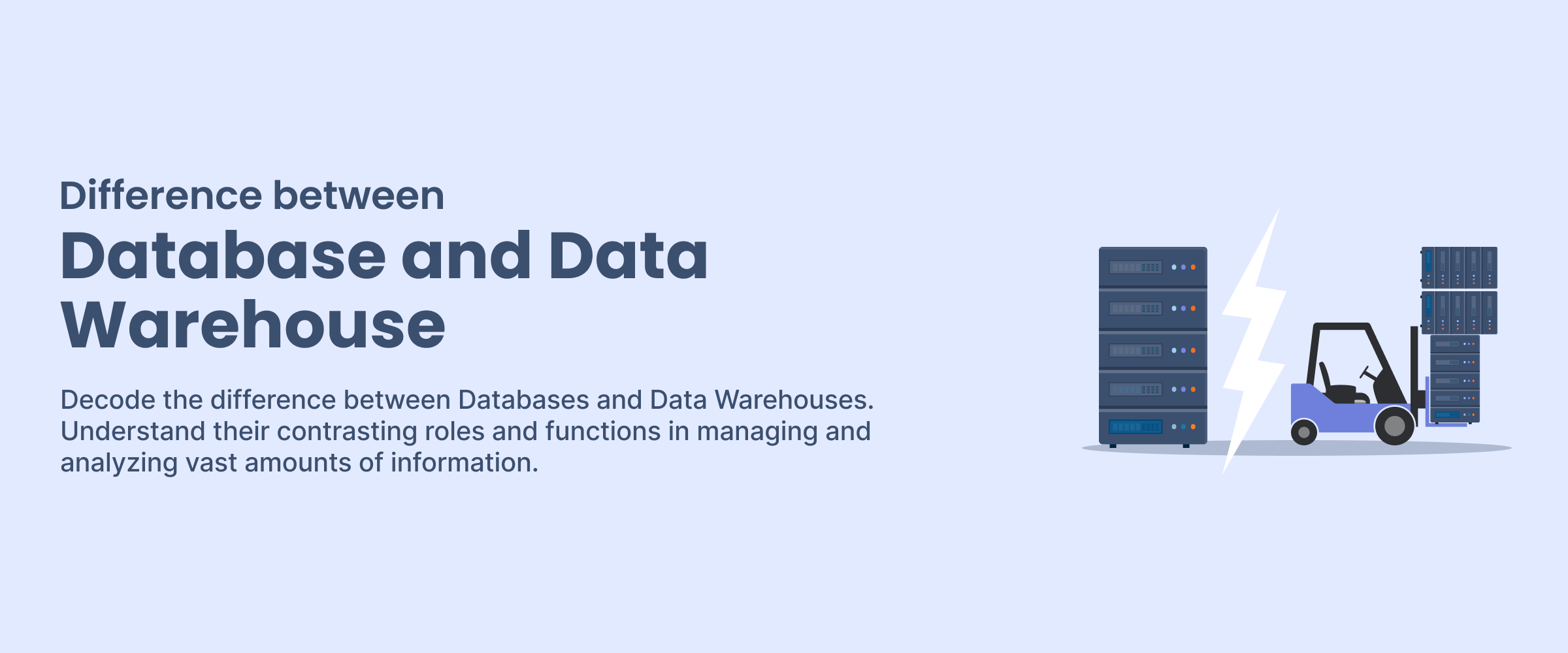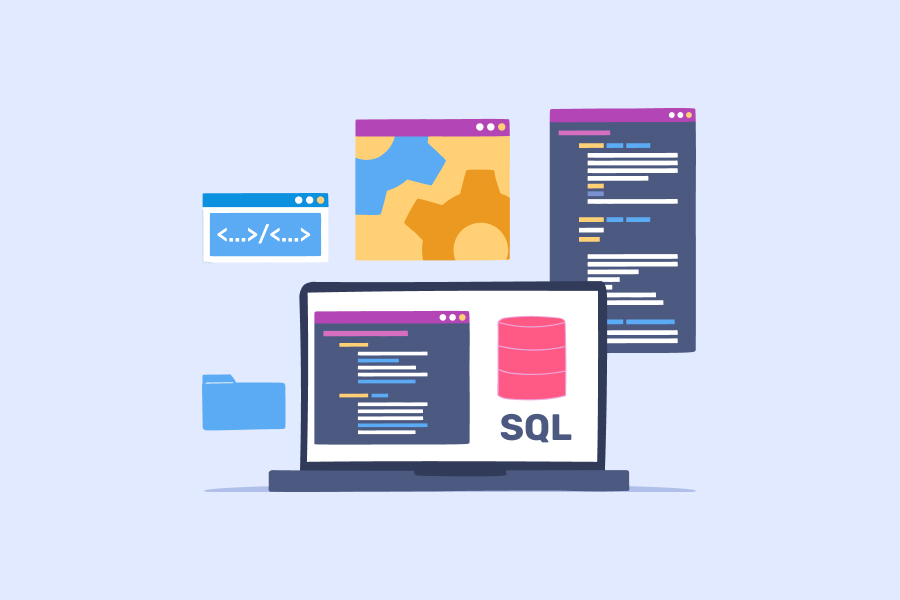Data Warehouse Vs Database: Understanding the Key Differences
Statistics state that the global data warehousing market will grow at a 12% compound annual growth rate through 2025. This is because the data warehouse is an integral component of data management. But so is a database. So how are the two different? While both are vital in handling data, they serve distinct purposes and possess unique characteristics.
In this blog, we will shed light on the key differences between databases and data warehouses and will look into their application to help you better understand when and how to use each of them effectively.
What is a Database?
A database is a structured collection of data that is organized and stored in a systematic way to enable efficient data retrieval, storage, and management. It typically consists of tables, rows, and columns, allowing for the storage and retrieval of information. Learn SQL to get started with database management and querying.
What is a Data warehouse?
A data warehouse is a specialized type of database designed for the centralized storage, integration, and analysis of large volumes of historical data from various sources. It serves as a repository for business intelligence and reporting, enabling organizations to make informed decisions based on comprehensive data analysis.
Data Warehouse vs. Database: Comparison Table
The difference between these two is crucial for understanding their respective roles and capabilities. Here are some key differences between a database and a data warehouse:
| Parameters | Database | Data Warehouse |
| Function | The Main function is to record data. It has transactional and operational workloads. | The main function is to analyze data. |
| Schema | The schema can be either flexible or rigid. It depends on the type of database. | The scheme is pre-defined or fixed. |
| Data Volume | It deals with a small volume of real-time data. | It deals with a large volume of historical data. |
| Performance & Query Type | It delivers rapid performance by utilizing transtional queries. | It uses complex queries for analytical purposes. Therefore, it is not ideal for real-time transactional operations. |
| Data Type | The data is up-to-date. The database stores the updated data. | The data is both historical and current. |
| Data Integration | It is designed for real-time data processing. | They employ ETL (Extract, Transform, Load) processes and workflows for data integration. |
| Users | Application developers use databases. | Business analysts and data scientists use data warehouses. |
| Business Intelligence (BI) | Their performance in BI is limited due to data structure-related constraints. | BI software connects seamlessly with data warehouses for analytical purposes. |
Get your dream job by enrolling in our data science course with placement.
Data Warehouse vs. Database – Key Differences
We have drawn a comparative analysis of the data warehouse and database in the above table. Let us now discuss these differences in detail.
Purpose and Function
Databases and a data warehouse serve distinct yet complementary purposes in the world of data management. Here are the purpose and functions of a database and a data warehouse:
- Databases – Databases are like organized digital filing cabinets. They are great for everyday tasks that need quick access and updates to information. They keep data reliable and consistent, which is perfect for things like online shopping or banking. In a database, data is sorted like a spreadsheet, making it easy to find and use specific info.
- Data Warehouses – Data warehouses are designed for analytical purposes. They serve as centralized repositories for historical and large volumes of data from various sources. Data warehouses are optimized for complex queries and reporting, making them ideal for tasks like data analysis, business intelligence, and data mining.
Data Structure and Schema
Data Structures and Schemes are fundamental concepts in the world of data management. Here is how databases and data warehouses are used in it:
- Databases – Databases usually organize data in a way that avoids repeating information and keeps everything consistent. They use multiple tables that are connected, and they make sure that the relationships between data are always correct. Plus, they are designed to handle changes to data easily.
- Data Warehouses – Data warehouses, use a denormalized or star-schema data structure. This configuration is finely tuned for efficient querying and reporting, facilitating swift data retrieval but is inflexible.
Data Volume and Historical Data
Here is how databases and data warehouses are used in managing and extracting value from vast reservoirs of information:
- Databases – Databases are ideally suited for managing smaller volumes of real-time data, making them highly effective for capturing and organizing current operational information. Although databases can also store historical data, their primary emphasis lies in handling present and recent data records.
- Data Warehouses – Data warehouses are proficient in managing extensive historical data, making them indispensable for analyzing trends and making long-term decisions. They are specifically designed to store and handle years’ worth of data, offering valuable insights into the historical perspective of business operations.
Performance and Query Complexity
Performance and query complexity determine how efficiently data management systems can process and retrieve information. Here is how a database and data warehouse is used:
- Databases – Databases excel in delivering rapid performance for straightforward queries and transactional tasks. They are finely tuned for swift data insertion, updates, and deletions. Their efficiency might diminish when confronted with intricate analytical inquiries that encompass extensive datasets.
- Data Warehouses – Data warehouses are designed to excel in handling complex analytical queries, including tasks such as aggregation, filtering, and data integration from various origins. They deliver impressive performance for reporting and data analysis tasks but may not be the ideal choice for real-time transactional operations.
Data Integration and ETL Processes
Data Integration and ETL (Extract, Transform, Load) processes are fundamental components of modern data management, here is how they are used:
- Databases – Although they may contribute as a source of data for integration, ETL processes usually occur independently of the database system. Databases are primarily designed for real-time data processing, and running ETL tasks within them can potentially affect their performance adversely.
- Data Warehouses – Data warehouses play a central role in the process of data integration and ETL (Extract, Transform, Load). They are specifically created to gather data from diverse sources, standardize it into a uniform structure, and subsequently store it in the warehouse, all to facilitate analytical activities.
Reporting and Business Intelligence
Reporting and Business Intelligence (BI) are essential components of modern data-driven decision-making. Here is how they are used:
- Databases – Databases can fulfill fundamental reporting and business intelligence requirements, particularly in the context of operational data. They are adept at producing straightforward reports and offering insights into live data. However, they might encounter challenges related to performance limitations and constraints associated with data structures.
- Data Warehouses – Data warehouses are finely tuned for handling intricate queries and analytical reporting tasks. Business intelligence software can seamlessly connect to data warehouses, empowering users to craft advanced reports, dashboards, and visualizations for extracting valuable insights from historical data.
Data Warehouse vs. Database: Applications
Now that we’ve explored the differences between databases and data warehouses, let’s delve into how these systems are commonly applied in real-world scenarios:
Applications of Data Warehouses
Here are some of the applications of Data Warehouse:
- Business Intelligence (BI) – Business Intelligence (BI) relies heavily on data warehouses. These repositories store historical data, enabling the creation of reports, dashboards, and data visualizations that empower informed decision-making.
- Analytics and Data Exploration – Data analysts and data scientists use data warehouses for comprehensive analysis, trend identification, and extracting valuable insights from historical data.
- Market Research – Data warehouses enable organizations to examine market patterns, customer actions, and competitive insights, empowering them to formulate strategic business choices.
- Financial Analysis – Financial institutions employ data warehouses to examine past financial data, aiding in risk evaluation, identifying fraudulent activities, and refining investment tactics.
- Supply Chain Optimization – Data warehouses offer valuable insights into the performance of supply chains, enabling organizations to enhance their inventory management, logistics, and distribution processes.
Applications of Databases
Here are some of the applications of databases:
- E-commerce and Online Retail – Databases serve as the core infrastructure of e-commerce platforms, playing a pivotal role in the real-time management of product listings, customer data, and transaction records.
- Customer Relationship Management (CRM) – Customer Relationship Management (CRM) systems utilize databases for the storage and retrieval of customer information, enabling tailored interactions and enhancing overall customer contentment.
- Inventory Management – Effective inventory management relies on databases to monitor stock levels, ascertain product availability, and facilitate order processing within the retail and supply chain sectors.
- Financial Services – Financial institutions, including banks, utilize databases to oversee account management, facilitate transaction processing, and guarantee the security and precision of financial information.
- Healthcare Systems – Healthcare systems rely on Electronic Health Records (EHR) systems, which utilize databases to store vital patient data, encompassing medical histories and treatment records.
- Human Resources – Human Resources (HR) systems use databases for efficient management of employee information, payroll processing, and performance assessments, thus optimizing HR planning.
Conclusion
Databases and Data Warehouses are versatile tools with distinct purposes in managing data. We have discussed them and their applications in the real world. We hope you found this info helpful. Now, we’re curious: Which part of the blog did you find most interesting? Was it the differences between database and data warehouse, their many uses, or the idea of using both together? Let us know in the comments below.






